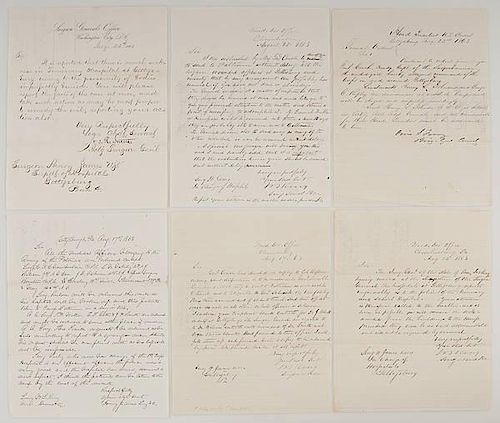Surgeon Henry Janes, Camp Letterman, Manuscript Archive on Gettysburg
About Seller
6270 Este Ave.
Cincinnati , OH 45232
United States
With offices in Cincinnati, Cleveland and Denver, Cowan’s holds over 40 auctions each year, with annual sales exceeding $16M. We reach buyers around the globe, and take pride in our reputation for integrity, customer service and great results. A full-service house, Cowan’s Auctions specializes in Am...Read more
Two ways to bid:
- Leave a max absentee bid and the platform will bid on your behalf up to your maximum bid during the live auction.
- Bid live during the auction and your bids will be submitted real-time to the auctioneer.
Bid Increments
| Price | Bid Increment |
|---|---|
| $0 | $25 |
| $500 | $50 |
| $1,000 | $100 |
| $2,000 | $250 |
| $5,000 | $500 |
| $10,000 | $1,000 |
| $20,000 | $2,500 |
| $50,000 | $5,000 |
| $100,000 | $10,000 |
About Auction
Nov 21, 2014 - Nov 22, 2014
Cowan's Auctions dawnie@cowans.com
- Lot Description
Surgeon Henry Janes, Camp Letterman, Manuscript Archive on Gettysburg
20 items.
Dr. Henry Janes (1832-1915) was Regimental Surgeon for the 3rd Vermont Infantry from its formation in June 1861 through the battle of Antietam. He was detailed to run two hospitals caring for the Antietam wounded, then was appointed Divisional medical officer of 2nd Division, VI Corps at Fredericksburg. After the battle, he went under flag of truce across enemy lines to treat and repatriate wounded Union soldiers.
Promoted to VI Corps medical officer, he traveled with the Corps to the battle of Gettysburg. After the battle, he helped treat more than 20,000 wounded Union and Confederate soldiers. The giant sprawling hospital complex that had been formed there was named Camp Letterman, for Medical Director of the Army of the Potomac Jonathan Letterman.
When the Army began its pursuit of Lee into Virginia, Letterman put Janes in charge. Janes, who like Letterman, constantly strived to improve the Army medical service, worked on procedures for treating the nearly always fatal gunshot fractures of the thigh besides amputation, saving the limbs of hundreds of soldiers. Dr Janes served throughout the war, advancing the science of treating major gunshot wounds.
This archive of 20 items date from August to December 1863, during Janes' tenure as commander of Army medical facilities at Gettysburg, and gives us some insight into the man in charge of saving as many lives as possible in the largest battlefield medical organization in history, up to that time.
By August, pressure was building to consolidate the number of temporary hospitals, so that the surgeons and staff could rejoin their regiments. The first letter, from District Head Quarters at Chambersburg, PA, dated August 15, 1863, notes a report that conditions at the Seminary in Gettysburg, which was being used as an emergency hospital, are unfavorable, and instructs Janes to transfer the wounded to medical camp set up outside town as soon as they can be safely moved. August 25 brings a letter from the Surgeon General's office in Washington, DC, again regarding the hospital at the Seminary: It is reported that there is much sickness in Seminary Hospital at Gettysburg, owing to the proximity of bodies imperfectly buried. You will please report the facts of the case at once, and take such action as may be most proper to remedy the evil; reporting your action also.
Janes replies to this letter on the 28th, noting that there is nothing to the rumor: There were a considerable number of confederate soldiers buried during the battle in one hole immediately to the rear of the building. These bodies have been exhumed and removed to the grave yard.
Many of the letters in the archive involve pressure on Janes to move Confederate wounded from the hospitals into POW camps at a faster pace.
Two letters, urging the removal of all Confederate wounded, but especially Generals Trimble and Kemper, to Baltimore without delay, seem curious until put into perspective. Confederate General John McCausland had been sent into Pennsylvania on a mission of revenge for the Union army burning homes in the Shenandoah Valley. McCausland hit Chambersburg on July 30, only 25 miles west of Gettysburg. It was also the headquarters of the Department of the Susquehanna. The Rebels demanded $100,000 in gold or $500,000 in greenbacks, or they would burn down the town. When the money was not forthcoming, over 500 homes and buildings were put to the torch.
This raised fears of a raid on Gettysburg to free the Confederate prisoners there. The first letter from Chambersburg, dated August 17, orders Trimble, Kemper, and any other Rebels able to withstand the journey, to be sent to Baltimore. Three days later, a more urgent order arrives: I am instructed by Maj Genl Couch to direct you to send to Baltimore without delay all the higher wounded officers at Gettysburg and vicinity that by any arrangement can possibly bear removal if you have not done so already. The General considers it a matter of importance that they should be removed at once and would like you to give your personal attention to the matter and strain a point of necessity to accomplish it. If General Trimble or Kemper could be removed into town a month ago, they are probably able to move now to Baltimore… A special messenger will bring you this and I need hardly add that it is important that the instructions herein given should be carried out without delay.
August 27 brings another letter regarding Confederate wounded, signed by Col. William Hoffman, Commissary General of Prisoners: I have to request that you will forward to the Depot on Johnsons Island near Sandusky O. all rebel officers among the sick and wounded prisoners in your charge, as fast as they are sufficiently recovered to bear the fatigue of the journey. None must be permitted to escape by being detained there beyond the proper time for their removal.
Two months later, it seemed that there were still a number of Confederates under medical care at Gettysburg, and that some people were not at all pleased with the latitude with which Janes was affording them:
Headquarters York District, Gettysburg: October 8th, 1863
Surgeon Janes,
I am directed by Brig Genl Ferry to call your attention to the fact that Rebel Prisoners both officers and men are allowed to visit Gettysburg upon passes issued by you. It is reported that Rebel officers have been seen in town as late as 11 o’clock P.M. in company with females.
It is not considered conducive to the best interests of this service to grant such permits to officers or men in the Rebel service except in cases of great necessity. and even then they should report in camp before sunset of the day on which the pass is given.
A week later, the decision was taken from Janes' hands: You will have all the Rebel wounded capable of being moved, also all Rebel Surgeons, Chaplains, Nurses, and attendants in Hospitals under your charge, removed to Baltimore by the early train tomorrow morning (Thursday Oct 15th) The Quarter Master of the Post will provide transportation.
On November 10, Dr. Janes writes to Col. Hoffman that there were 5090 Confederates of all ranks listed as being treated in the various hospitals at Gettysburg under his command, and that the names, ranks, and units will be supplied once the staff has processed the pay rolls for the 15,000 Union wounded. The rolls apparently ended up being lost in transit, as on December 5, Janes replies that there was no persistent delay in furnishing them, and that in any case, he had no clerks but random privates pulled from ranks to handle the paperwork from treating 20,000 wounded.
A November 10 letter on US Sanitary Commission letterhead from New York to Dr. Janes asks what the procedures are for the Commission being repaid for the $900 expended at Gettysburg for assistance to the wounded. This ALS is from the Rev. Dr. Gordon Winslow, Sr., who also served as chaplain to the Duryee's Zouaves/5th NY Infantry. The Rev. Winslow died in June 1864, when he fell from a hospital steamer while accompanying his wounded son Col. Cleveland Winslow after the Colonel's mortal wound at Cold Harbor. - Shipping Info
-
SHIPPING. At the request of the buyer, Cowan's will authorize the shipment of purchased items. Shipments usually occur within two weeks after payment has been received. Shipment is generally made via UPS Ground service. Unless buyer gives special instructions, the shipping method shall be at the sole discretion of Cowan's Auctions, Inc.. Cowan's is in no way responsible for the acts or omissions of independent handlers, packers or shippers of purchased items or for any loss, damage or delay from the packing or shipping of any property.
-
- Buyer's Premium



 EUR
EUR CAD
CAD AUD
AUD GBP
GBP MXN
MXN HKD
HKD CNY
CNY MYR
MYR SEK
SEK SGD
SGD CHF
CHF THB
THB






